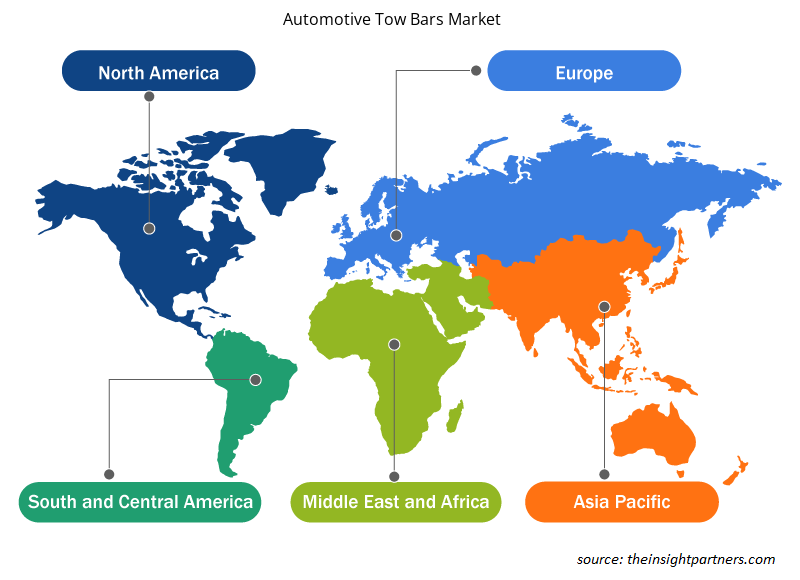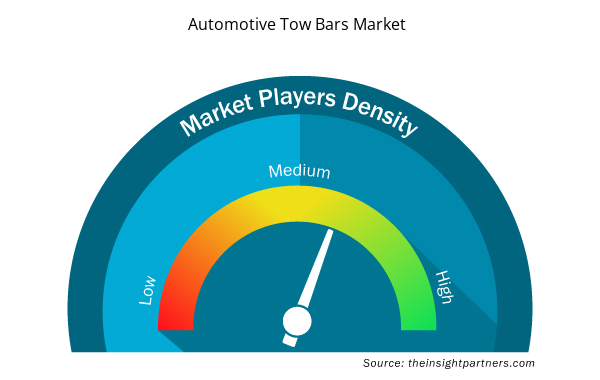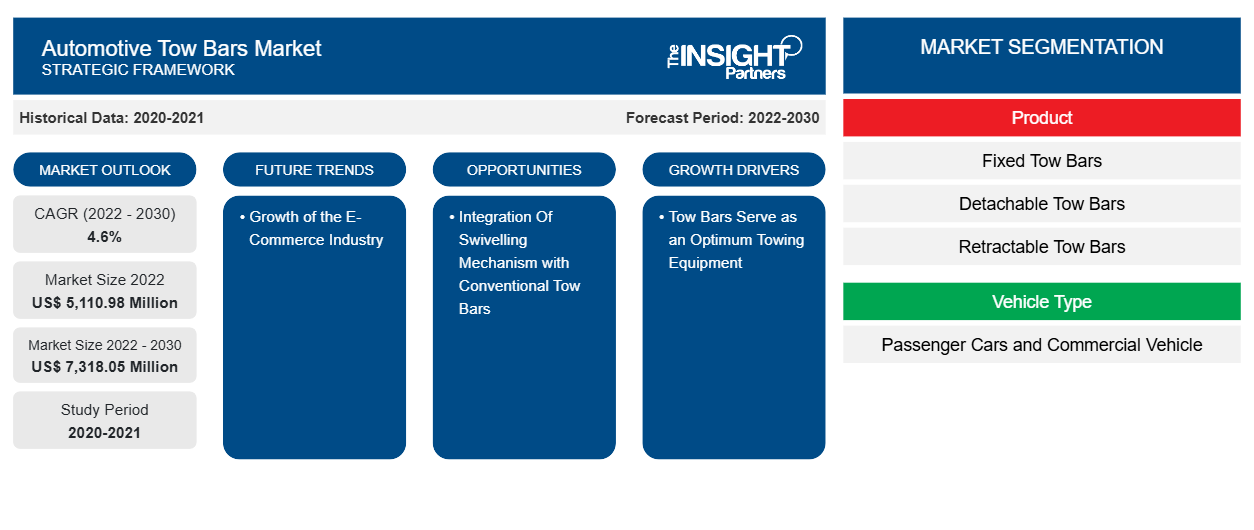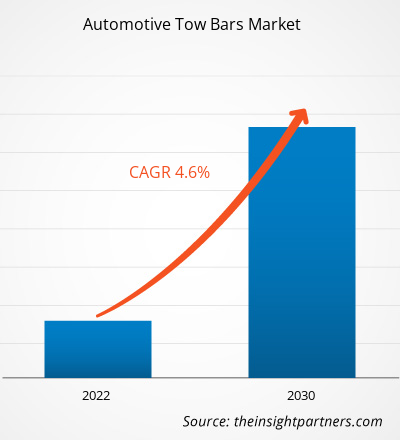Der Markt für Anhängerkupplungen für Kraftfahrzeuge wurde im Jahr 2022 auf 5.110,98 Millionen US-Dollar geschätzt und soll bis 2030 7.318,05 Millionen US-Dollar erreichen; für den Zeitraum 2022–2030 wird eine durchschnittliche jährliche Wachstumsrate (CAGR) von 4,6 % erwartet.
Analystenperspektive:
Die Anhängerkupplung dient zum Abschleppen eines liegengebliebenen Fahrzeugs und sorgt gleichzeitig für die Balance, um ein Schleudern zu vermeiden. Der globale Markt für Anhängerkupplungen für Autos ist in fünf große Regionen unterteilt: Nordamerika, Europa, Asien-Pazifik, Naher Osten und Afrika sowie Süd- und Mittelamerika. Die wachsende Beliebtheit von Abenteuersport- und Freizeitfahrzeugen (RVs) treibt die Nachfrage nach Anhängerkupplungen für Autos an. Die steigenden Verkäufe von Personenkraftwagen unterstützen auch das Wachstum des Marktes für Anhängerkupplungen für Autos. Laut dem Verband der europäischen Automobilhersteller (ACEA) machen Europa und Nordamerika etwa 34,6 % aller weltweit hergestellten Autos aus. Europa wird voraussichtlich die höchste durchschnittliche jährliche Wachstumsrate auf dem Markt für Anhängerkupplungen für Autos verzeichnen, gefolgt von Nordamerika und APAC.
Die Nachfrage nach Anhängerkupplungen für Autos steht in direktem Zusammenhang mit den Pkw-Verkäufen. So unterstützen die steigenden Pkw-Verkäufe in entwickelten Regionen wie Europa und Nordamerika das Wachstum des Marktes für Anhängerkupplungen für Autos.
Meistens entscheiden sich Caravan-Nutzer für Anhängerkupplungen, um ihren Wohnwagen zu ziehen. Auf dem Markt sind verschiedene Arten von Anhängerkupplungen für eine Vielzahl von Zubehör erhältlich und sie erfreuen sich in Großbritannien großer Beliebtheit. Die elektrische Anhängerkupplung wird immer beliebter, was den auf dem Markt für Anhängerkupplungen für Kraftfahrzeuge tätigen Unternehmen die Möglichkeit bietet, in den kommenden Jahren einen starken Kundenstamm aufzubauen.
Marktübersicht:
Das steigende verfügbare Einkommen in verschiedenen Entwicklungsländern, die große Neigung zu Abenteueraktivitäten und die zunehmende Nutzung von Wohnwagen und Wohnmobilen treiben das Wachstum des Marktes für Auto-Anhängerkupplungen voran. Die Nachfrage nach Auto-Anhängerkupplungen dürfte aufgrund des zunehmenden Trends zu schleppbaren Freizeitfahrzeugen stark ansteigen. Elektrische Anhängerkupplungen können über einen Schalter bedient werden. Daher wird erwartet, dass die Nachfrage nach elektrischen Anhängerkupplungen im Prognosezeitraum aufgrund der zunehmenden Präferenz für Sports Utility Vehicles (SUV) und Geländefahrzeuge moderat wachsen wird. Steigende Investitionen in den Bau von Fabriken und die Erweiterung von Automobilproduktionsstätten würden die Nachfrage nach Personenkraftwagen und Nutzfahrzeugen ankurbeln. Daher wird erwartet, dass diese Schlüsselfaktoren das Wachstum des Marktes für Auto-Anhängerkupplungen in den Jahren 2020–2027 vorantreiben werden.
Darüber hinaus verfolgen verschiedene Unternehmen auf dem Markt für Anhängerkupplungen für Autos viele Strategien wie Produktentwicklung und Akquisition, um der Konkurrenz einen Schritt voraus zu sein. Im März 2020 stellte Curt Manufacturing eine neue, nicht bindende Anhängerkupplung vor – die Rambler-Anhängerkupplung aus Stahl. Das neu eingeführte Produkt verfügt über einen automatischen Verriegelungsmechanismus, drei Verstaupositionen und rutschfeste Arme für bessere Kontrolle und Handhabung. Daher treiben anorganische Marktstrategien das Wachstum des Marktes für Anhängerkupplungen für Autos voran.
Passen Sie diesen Bericht Ihren Anforderungen an
Sie erhalten kostenlos individuelle Anpassungen an jedem Bericht, einschließlich Teilen dieses Berichts oder einer Analyse auf Länderebene, eines Excel-Datenpakets sowie tolle Angebote und Rabatte für Start-ups und Universitäten.
- Holen Sie sich die wichtigsten Markttrends aus diesem Bericht.Dieses KOSTENLOSE Beispiel umfasst eine Datenanalyse von Markttrends bis hin zu Schätzungen und Prognosen.
Markttreiber:
Erhöhte Automobilproduktion treibt das Wachstum des Marktes für Anhängerkupplungen an
In den letzten Jahren hat der Anstieg der Automobilproduktion, insbesondere in den hochentwickelten Regionen wie Nordamerika und Europa, das Wachstum des Marktes für Anhängerkupplungen für Autos vorangetrieben. Die Anhängerkupplung für Autos ist als Standard-Filament oder als Zusatzfunktion bei den meisten Premium-Pkw-Modellen erhältlich, die von Automobilgiganten wie Audi, Range Rover, BMW und Ford Motor Company auf den Markt gebracht werden. Das schnelle Wachstum der Automobilproduktion in hochentwickelten Volkswirtschaften auf der ganzen Welt stärkt die Nachfrage nach Anhängerkupplungen im Automobilsektor. Elektrofahrzeuge und Hybridelektrofahrzeuge gewinnen auf dem Markt an Bedeutung. Nachhaltige Entwicklung und die daraus resultierende Nachfrage nach umweltfreundlichen Autos haben zur Entstehung von Elektrofahrzeugen und anderen erneuerbaren Energiequellen wie Solar-, Wind- und Biokraftstoffen geführt. Darüber hinaus wird die Nutzung dieser Fahrzeuge durch mehrere Regierungsinitiativen gefördert, wie etwa die Zahlung von Anreizen und Steuervorteilen an Anwender umweltfreundlicher Fahrzeuge. Somit treiben die schnell steigenden Akzeptanzraten von Elektro- und Hybridfahrzeugen das Wachstum des Marktes für Anhängerkupplungen für Autos voran.
Segmentanalyse:
Basierend auf dem Produkt ist der Markt für Anhängerkupplungen für Autos in einziehbare Anhängerkupplungen, feste Anhängerkupplungen, abnehmbare Anhängerkupplungen und Sonstiges unterteilt.
Eine einziehbare Anhängerkupplung ist eine schlanke, schwanenhalsförmige Anhängerkupplung, die sich unter der Stoßstange drehen lässt. Die einziehbare Anhängerkupplung lässt sich je nach Bedarf leicht einziehen oder ausfahren; in eingezogener Position ist die Anhängerkupplung vollständig verborgen. Die Anhängerkupplungskugel und der Anhängerkupplungshals des einziehbaren Produkts bestehen aus einem Stück und lassen sich mühelos in Sekundenschnelle von Hand drehen, sodass sie im Raum zwischen der Heckverkleidung und der Stoßstange des Fahrzeugs platziert wird. Diese Anhängerkupplung bietet Komfort und Benutzerfreundlichkeit. Sie lässt sich leicht zusammenklappen, ist benutzerfreundlich und in Sekundenschnelle einsatzbereit. Sie funktioniert elektrisch oder über einen bequem positionierten Entriegelungsmechanismus. Die einziehbare Anhängerkupplung dreht sich automatisch unter der Stoßstange hervor und kann sofort verwendet werden. Einziehbare Anhängerkupplungen bieten ein diskretes Erscheinungsbild; ihre zusätzliche Komplexität könnte in Zukunft möglicherweise Probleme verursachen. Eine ordnungsgemäße Wartung und Instandhaltung würde jedoch mögliche Zuverlässigkeitsprobleme abmildern. Darüber hinaus dürfte die steigende Zahl von Personenkraftwagen und Nutzfahrzeugen in mehreren potenziellen Regionen die Nachfrage nach schwenkbaren Anhängerkupplungen im Prognosezeitraum steigern.
Regionale Einblicke in den Markt für Anhängerkupplungen für Kraftfahrzeuge
Die regionalen Trends und Faktoren, die den Markt für Anhängerkupplungen für Kraftfahrzeuge im Prognosezeitraum beeinflussen, wurden von den Analysten von Insight Partners ausführlich erläutert. In diesem Abschnitt werden auch die Marktsegmente und die Geografie für Anhängerkupplungen für Kraftfahrzeuge in Nordamerika, Europa, im asiatisch-pazifischen Raum, im Nahen Osten und Afrika sowie in Süd- und Mittelamerika erörtert.

- Erhalten Sie regionale Daten zum Markt für Anhängerkupplungen für Kraftfahrzeuge
Umfang des Marktberichts für Anhängerkupplungen für Kraftfahrzeuge
| Berichtsattribut | Details |
|---|---|
| Marktgröße im Jahr 2022 | 5.110,98 Millionen US-Dollar |
| Marktgröße bis 2030 | 7.318,05 Millionen US-Dollar |
| Globale CAGR (2022 - 2030) | 4,6 % |
| Historische Daten | 2020-2021 |
| Prognosezeitraum | 2022–2030 |
| Abgedeckte Segmente | Nach Produkt
|
| Abgedeckte Regionen und Länder | Nordamerika
|
| Marktführer und wichtige Unternehmensprofile |
|
Marktteilnehmerdichte für Anhängerkupplungen für Kraftfahrzeuge: Auswirkungen auf die Geschäftsdynamik verstehen
Der Markt für Anhängerkupplungen für Kraftfahrzeuge wächst rasant. Dies wird durch die steigende Nachfrage der Endnutzer aufgrund von Faktoren wie sich entwickelnden Verbraucherpräferenzen, technologischen Fortschritten und einem größeren Bewusstsein für die Vorteile des Produkts vorangetrieben. Mit der steigenden Nachfrage erweitern Unternehmen ihr Angebot, entwickeln Innovationen, um die Bedürfnisse der Verbraucher zu erfüllen, und nutzen neue Trends, was das Marktwachstum weiter ankurbelt.
Die Marktteilnehmerdichte bezieht sich auf die Verteilung der Firmen oder Unternehmen, die in einem bestimmten Markt oder einer bestimmten Branche tätig sind. Sie gibt an, wie viele Wettbewerber (Marktteilnehmer) in einem bestimmten Marktraum im Verhältnis zu seiner Größe oder seinem gesamten Marktwert präsent sind.
Die wichtigsten auf dem Markt für Anhängerkupplungen für Kraftfahrzeuge tätigen Unternehmen sind:
- AutoPacific Australia Pty Ltd
- Bosal-Gruppe
- Brink-Gruppe
- BTA Abschleppausrüstung
- CURT Manufacturing LLC
- Oris
Haftungsausschluss : Die oben aufgeführten Unternehmen sind nicht in einer bestimmten Reihenfolge aufgeführt.

- Überblick über die wichtigsten Akteure auf dem Markt für Anhängerkupplungen für Kraftfahrzeuge
Regionale Analyse:
Der Marktanteil von Anhängerkupplungen für Kraftfahrzeuge ist in fünf Hauptregionen unterteilt: Nordamerika, Europa, APAC, MEA und SAM.
Die USA, Kanada und Mexiko gehören zu den größten Volkswirtschaften Nordamerikas. Der technologische Fortschritt hat zu einem äußerst wettbewerbsintensiven Markt in Nordamerika geführt, da die wachsende Bevölkerung aufgrund ihrer hohen Kaufkraft mehrere technologische Entwicklungen anzieht. Die Region verfügt über eines der größten Automobilproduktionszentren der Welt. Die Präsenz namhafter Automobilhersteller und Komponentenhersteller treibt den Marktwert in die Höhe. Das Wirtschaftswachstum Nordamerikas hat den Verkauf von Personenkraftwagen und Nutzfahrzeugen erhöht. Anhängerkupplungen werden von Personenkraftwagen, leichten Nutzfahrzeugen und schweren Nutzfahrzeugen verwendet; sie sind stark genug, dass sie beim Ziehen von Anhängern nicht zerfallen. Die wachsenden Verkäufe von Personenkraftwagen und Nutzfahrzeugen erhöhen die Nachfrage nach Anhängerkupplungen für Kraftfahrzeuge. Der Verband der europäischen Automobilhersteller (ACEA) gab im Jahr 2021 an, dass in Europa 13,58 Millionen Einheiten von Personenkraftwagen und Nutzfahrzeugen produziert wurden. Die Verwendung von Leichtbaumaterialien zur Konstruktion von Anhängerkupplungen kann das Gewicht von Fahrzeugen reduzieren und die Kraftstoffeffizienz verbessern, was in den kommenden Jahren lukrative Möglichkeiten für den Markt für Anhängerkupplungen für Kraftfahrzeuge bieten würde. Mehrere technologische Fortschritte in der Materialwissenschaft haben zu einem Boom auf dem Markt für Anhängerkupplungen für Autos geführt. Die Entwicklungen haben es den Herstellern ermöglicht, Polymere oder Metalle mit höherer Zugfestigkeit zu verwenden, was die Funktionalität der Anhängerkupplung und ihre Lebensdauer erheblich verbessern könnte. Der wichtigste Faktor, der das Wachstum des Marktes für Anhängerkupplungen für Autos vorantreibt, ist die rasche Entwicklung der Herstellungstechniken für Anhängerkupplungen und ihrer Materialien. Darüber hinaus wird erwartet, dass die Weiterentwicklung von elektrischen Anhängerkupplungen in Nordamerika im Prognosezeitraum aufgrund der steigenden Nachfrage nach SUVs, die die Hersteller dazu ermutigt, die Produktion von SUVs zu steigern, mit moderater Geschwindigkeit voranschreitet.
Schlüsselspieleranalyse:
Zu den wichtigsten Akteuren auf dem Markt für Anhängerkupplungen für Kraftfahrzeuge zählen AutoPacific Australia Pty Ltd, Bosal Group, Brink Group, BTA Towing Equipment, CURT Manufacturing LLC, Oris, PCT Automotive Limited, Alois Kober GmbH, North Shore Tow Bars und GDW NV.
Aktuelle Entwicklungen:
Anorganische und organische Strategien wie Fusionen und Übernahmen werden von Unternehmen auf dem globalen Markt für Anhängerkupplungen für Kraftfahrzeuge häufig eingesetzt. Nachfolgend sind einige aktuelle Entwicklungen der wichtigsten Akteure auf dem Markt für Anhängerkupplungen für Kraftfahrzeuge aufgeführt:
Jahr | Nachricht |
November 2020 | Der Auspuff- und Tourenausrüstungshersteller Bosal gab den Umbau seiner Anhängerkupplungsabteilung bekannt, um sowohl den Ersatzteilmarkt als auch die Händlermontage an Neufahrzeugen zu bedienen. |
März 2020 | Curt Manufacturing hat eine neue, nicht bindende Rambler-Anhängerkupplung aus Stahl vorgestellt. Das neu eingeführte Produkt verfügt über einen automatischen Verriegelungsmechanismus, drei Verstaupositionen und rutschfeste Arme für bessere Kontrolle und Handhabung. |
- Historische Analyse (2 Jahre), Basisjahr, Prognose (7 Jahre) mit CAGR
- PEST- und SWOT-Analyse
- Marktgröße Wert/Volumen – Global, Regional, Land
- Branche und Wettbewerbsumfeld
- Excel-Datensatz



Report Coverage
Revenue forecast, Company Analysis, Industry landscape, Growth factors, and Trends

Segment Covered
This text is related
to segments covered.

Regional Scope
North America, Europe, Asia Pacific, Middle East & Africa, South & Central America

Country Scope
This text is related
to country scope.
Häufig gestellte Fragen
In the past few years, the increase in automotive production, particularly in the advanced regions, including North America and Europe, has driven the growth of the automotive tow bars market. The tow bar for automobiles is available as a standard filament or as an additional feature with most premium passenger car models launched by automotive giants such as Audi, Range Rover, BMW, and Ford Motor Company.
Prominent market vendors have launched electrically operated tow bars for both OEMs and the aftermarket segments of the automotive sector. These tow bars are designed to improve the functionality of conventional tow bars and offer users convenience in terms of operability.
The US, Canada, and Mexico are major economies in North America. Technological advancements have led to a highly competitive market in the region as the increasing population attracts several technological developments due to high spending power. The region has one of the largest automotive manufacturing hubs in the globe.
Bosal Group, Brink Group, CURT Manufacturing LLC, Oris, and PCT Automotive Limited are the key market players operating in the global automotive tow bars market.
Smart tow bars equipped with wireless connectivity and remote-control capabilities make it easier for users to manage towing tasks. Users can control the tow bar from their smartphone or tablet, eliminating the need for manual adjustments and simplifying the hitching and unhitching process.
Trends and growth analysis reports related to Automotive and Transportation : READ MORE..
The List of Companies - Automotive Tow Bars Market
- AutoPacific Australia Pty Ltd
- Bosal Group
- Brink Group
- BTA Towing Equipment
- CURT Manufacturing LLC
- Oris
- PCT Automotive Limited
- Alois Kober GmbH
- North Shore Tow bars
- GDW NV
The Insight Partners performs research in 4 major stages: Data Collection & Secondary Research, Primary Research, Data Analysis and Data Triangulation & Final Review.
- Data Collection and Secondary Research:
As a market research and consulting firm operating from a decade, we have published and advised several client across the globe. First step for any study will start with an assessment of currently available data and insights from existing reports. Further, historical and current market information is collected from Investor Presentations, Annual Reports, SEC Filings, etc., and other information related to company’s performance and market positioning are gathered from Paid Databases (Factiva, Hoovers, and Reuters) and various other publications available in public domain.
Several associations trade associates, technical forums, institutes, societies and organization are accessed to gain technical as well as market related insights through their publications such as research papers, blogs and press releases related to the studies are referred to get cues about the market. Further, white papers, journals, magazines, and other news articles published in last 3 years are scrutinized and analyzed to understand the current market trends.
- Primary Research:
The primarily interview analysis comprise of data obtained from industry participants interview and answers to survey questions gathered by in-house primary team.
For primary research, interviews are conducted with industry experts/CEOs/Marketing Managers/VPs/Subject Matter Experts from both demand and supply side to get a 360-degree view of the market. The primary team conducts several interviews based on the complexity of the markets to understand the various market trends and dynamics which makes research more credible and precise.
A typical research interview fulfils the following functions:
- Provides first-hand information on the market size, market trends, growth trends, competitive landscape, and outlook
- Validates and strengthens in-house secondary research findings
- Develops the analysis team’s expertise and market understanding
Primary research involves email interactions and telephone interviews for each market, category, segment, and sub-segment across geographies. The participants who typically take part in such a process include, but are not limited to:
- Industry participants: VPs, business development managers, market intelligence managers and national sales managers
- Outside experts: Valuation experts, research analysts and key opinion leaders specializing in the electronics and semiconductor industry.
Below is the breakup of our primary respondents by company, designation, and region:

Once we receive the confirmation from primary research sources or primary respondents, we finalize the base year market estimation and forecast the data as per the macroeconomic and microeconomic factors assessed during data collection.
- Data Analysis:
Once data is validated through both secondary as well as primary respondents, we finalize the market estimations by hypothesis formulation and factor analysis at regional and country level.
- Macro-Economic Factor Analysis:
We analyse macroeconomic indicators such the gross domestic product (GDP), increase in the demand for goods and services across industries, technological advancement, regional economic growth, governmental policies, the influence of COVID-19, PEST analysis, and other aspects. This analysis aids in setting benchmarks for various nations/regions and approximating market splits. Additionally, the general trend of the aforementioned components aid in determining the market's development possibilities.
- Country Level Data:
Various factors that are especially aligned to the country are taken into account to determine the market size for a certain area and country, including the presence of vendors, such as headquarters and offices, the country's GDP, demand patterns, and industry growth. To comprehend the market dynamics for the nation, a number of growth variables, inhibitors, application areas, and current market trends are researched. The aforementioned elements aid in determining the country's overall market's growth potential.
- Company Profile:
The “Table of Contents” is formulated by listing and analyzing more than 25 - 30 companies operating in the market ecosystem across geographies. However, we profile only 10 companies as a standard practice in our syndicate reports. These 10 companies comprise leading, emerging, and regional players. Nonetheless, our analysis is not restricted to the 10 listed companies, we also analyze other companies present in the market to develop a holistic view and understand the prevailing trends. The “Company Profiles” section in the report covers key facts, business description, products & services, financial information, SWOT analysis, and key developments. The financial information presented is extracted from the annual reports and official documents of the publicly listed companies. Upon collecting the information for the sections of respective companies, we verify them via various primary sources and then compile the data in respective company profiles. The company level information helps us in deriving the base number as well as in forecasting the market size.
- Developing Base Number:
Aggregation of sales statistics (2020-2022) and macro-economic factor, and other secondary and primary research insights are utilized to arrive at base number and related market shares for 2022. The data gaps are identified in this step and relevant market data is analyzed, collected from paid primary interviews or databases. On finalizing the base year market size, forecasts are developed on the basis of macro-economic, industry and market growth factors and company level analysis.
- Data Triangulation and Final Review:
The market findings and base year market size calculations are validated from supply as well as demand side. Demand side validations are based on macro-economic factor analysis and benchmarks for respective regions and countries. In case of supply side validations, revenues of major companies are estimated (in case not available) based on industry benchmark, approximate number of employees, product portfolio, and primary interviews revenues are gathered. Further revenue from target product/service segment is assessed to avoid overshooting of market statistics. In case of heavy deviations between supply and demand side values, all thes steps are repeated to achieve synchronization.
We follow an iterative model, wherein we share our research findings with Subject Matter Experts (SME’s) and Key Opinion Leaders (KOLs) until consensus view of the market is not formulated – this model negates any drastic deviation in the opinions of experts. Only validated and universally acceptable research findings are quoted in our reports.
We have important check points that we use to validate our research findings – which we call – data triangulation, where we validate the information, we generate from secondary sources with primary interviews and then we re-validate with our internal data bases and Subject matter experts. This comprehensive model enables us to deliver high quality, reliable data in shortest possible time.


 Holen Sie sich ein kostenloses Muster für diesen Bericht
Holen Sie sich ein kostenloses Muster für diesen Bericht